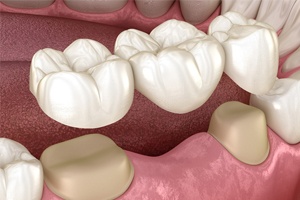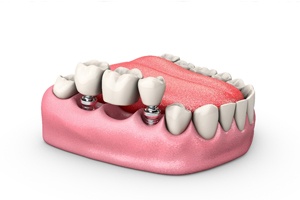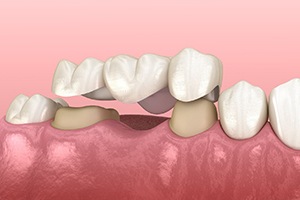Dental Bridges –Carrollton, TX
Replacing Missing Teeth with a Secure Restoration
At Aegis Dental, we strive to provide all our patients with the highest level of care while restoring and repairing smiles. When it comes to missing one tooth or multiples in a row, we understand the impact it can have on your visual appearance and your self-esteem. By choosing to get a dental bridge in Carrollton, you can once again have a complete smile that functions naturally and gives you the confidence you need and deserve.
What is a Dental Bridge?

A dental bridge is a kind of prosthetic we can use to replace a single missing tooth or a few in a row. It consists of a prosthetic tooth or teeth that are supported by neighboring crowns.
To get one, two crowns are placed on the teeth on either side of the gap in a patient’s smile, and the new teeth are bonded directly to them. This not only helps the appearance of the smile, but it also ensures that the bite is evenly distributed. Plus, it prevents the other teeth from shifting out of place, which happens often after tooth loss.
Who is a Good Candidate for Dental Bridges?

To be eligible for a dental bridge, your dentist in Carrollton must thoroughly evaluate and examine your mouth. If you are missing one or multiple consecutive teeth on a row, you’re most likely a qualified candidate. However, you must have good oral and overall health and have no signs of gum disease.
What’s so important about gum disease? Patients who have inflamed, bleeding gums will need to be treated with periodontal therapy before having a dental bridge placed. This is because gum disease can lead to tooth loss if left untreated, ultimately causing your bridge to fail.
What Are the Benefits of Dental Bridges?

- Restores the visual appearance of your smile
- Allows you to maintain your overall facial appearance
- Prevents nearby teeth from shifting or moving out of alignment
- Evenly distributes the bite force
- Restores your ability to speak and chew with confidence
How Do Implant-Retained Bridges Work?

Should you opt for a more stable solution – an implant-retained bridge, there are few qualifications you’ll need to meet:
- Good oral and overall health
- Enough bone density to support the implants
- Stop smoking
To receive an implant-retained bridge, we will insert implants into areas on both sides of the gap, securing them into the jawbone. It will be necessary that you spend a few months healing and allowing the implant to properly fuse to the jawbone before receiving your customized bridge.
Once you are fully healed, you’ll return to our office and have the abutments placed (the appliance that connects the implant to the restoration) as well as your custom-made dental bridge. This will be matched to your natural tooth color, size, and shape, so your bridge will blend in seamlessly with your smile.
What Are Their Advantages?

- Greater stability because the implants are surgically placed into the jawbone
- They can last decades with proper care and maintenance
- Offer patients increase confidence in their ability to speak, chew and eat
- Improved facial appearance
With crowns and bridges, we can turn back the clock and make it seem like nothing bad ever happened to your smile. To learn more about them or schedule an appointment, contact us today.
Dental Bridge FAQs

There is a good possibility that you have questions about dental bridges in Carrollton. Learning you need a customized prosthetic to fill in the gap in your smile can leave you wondering about what life will be like after it is put into place. You may also wonder about the actual placement process. This is why Dr. Chandy is here to answer some of the most common questions asked by patients. Review the information below and feel free to contact our team for further details.
Can you take a dental bridge out?
No, once a dental bridge is put into place, it cannot be removed except only by a trusted and experienced dental professional. Although they are not designated as “permanent,” they are meant to last 10 years or longer with proper care. If you are looking for a removable option, it may be that you’ll want to talk to Dr. Chandy about a partial denture as opposed to a traditional, fixed bridge.
Is getting a dental bridge painful?
When receiving a dental bridge, you will be administered local anesthesia by your dentist in Carrollton. This will numb specific areas of your mouth while ensuring you remain free of any pain throughout the placement process. However, once your treatment is complete, there is the possibility of experiencing some soreness and sensitivity. The good news is that an over-the-counter pain reliever can help to minimize discomfort.
For individuals who prefer an implant bridge, there will be pain and soreness immediately after oral surgery simply because the posts are embedded into the jawbone. Appropriate aftercare instructions will be provided to ensure a successful recovery.
How many teeth can a dental bridge replace?
Dental bridges are commonly recommended if you are missing one to four teeth. Ultimately, your dentist will determine if a partial denture or regular bridge is the best fit for your situation, but a general rule of thumb is that bridges cannot withstand wear and tear if it is too long. It begins to lack the necessary stability to hold up to biting and chewing if more than three or four teeth are missing.
An implant bridge, however, can withstand this type of pressure because it is held into place using titanium implant posts, which are secured into the jawbone.
Can dental bridges get cavities?
It is impossible for a dental bridge to develop cavities; however, the teeth underneath certainly can. Although your natural abutment teeth are altered to help hold the bridge in place, bacteria can spread beneath the prosthetic and attack the underlying structure. If left untreated, the teeth can become infected and develop cavities. This can cause your bridge to fail as well as the potential of additional tooth loss depending on the severity of the decay. This is why we strongly recommend our patients practice optimal oral hygiene at all times.
